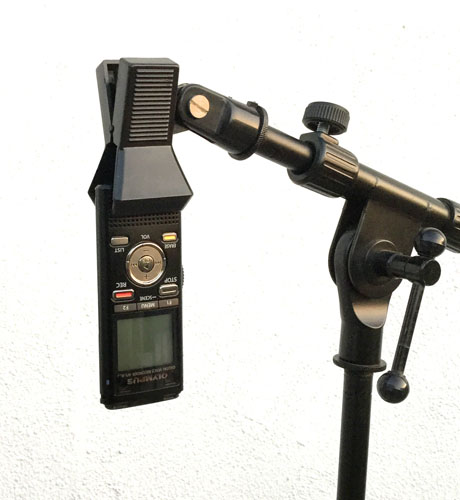I’m struggling to get my voice to sound good with this mic. I haven’t really touched the settings on audacity and I’m using the setting on the mic that records what is just in front of it. I have mainly used the effects compressor, equalize, normalize and noise removal but in the video I am uploading tonight I used Amplify, click removal, and truncate silence. Here’s my channel: https://www.youtube.com/user/Wikividz/videos
…I can’t watch your video because I’m at work.
I have mainly used the effects compressor, equalize, normalize and noise removal but in the video I am uploading tonight I used Amplify, click removal, and truncate silence.
That’s an awful lot of processing. What was wrong before you did all of that stuff?
Are you using the mic’s directional setting?
Once you’ve got a good microphone and interface (and a good “performance” to record), most issues are related to your “studio” environment (acoustic noise and reflections). If the noise isn’t too bad, noise reduction may help. But reflections (usually short-duration reverberation) is impossible to remove.
I probably wouldn’t give an army to a dead monarch, either.
I can only find two actual problems with your presentation on “Pink Diamond.”
You are PPopping your PP sounds.
This is an extreme example.
http://kozco.com/tech/audacity/clips/PPopping.mp3
It sounds like Chase has his mouth jammed right up against the microphone so every P and B makes noises. You maybe able to just back away a little and get rid of all yours. You might also try to suppress them in post production filtering. Steve designed a voice sound filter to get rid of rumble, low pitch sounds. heavy truck noises and thunder. It might also make it so you don’t need to do quite so much noise reduction which is the other complaint.
Your voice is too “tight” and sometimes swimmy and honky which happens when you overdo noise reduction.
You can download and install LF Rolloff in Effect > Equalization.
http://www.kozco.com/tech/audacity/Documents/LF_rolloff_for_speech.xml.zip
Unzip it to LF_rolloff_for_speech.xml. Install it like this.
Adding Audacity Equalization Curves
– Select something on the timeline.
– Effect > Equalization > Save/Manage Curves > Import
– Select LF_rolloff_for_speech.xml > OK. (it won’t open the ZIP. You have to decompress it)
– LF rolloff for speech now appears in the equalization preset curve list.
Select your raw performance and Effect > Equalization: LF rolloff for speech > OK
Post a segment of your show with no processing, or announce a fresh one according to this:
http://www.kozco.com/tech/audacity/TestClip/Record_A_Clip.html
Scroll down from a forum text page > Upload attachment > Browse.
We may be able to adjust your processing so you don’t have to change anything else.
Koz
Let me know if I lose you anywhere.
Koz
There is a microphone technique that may be handy. Move the microphone to the left—sort of opposite your cheek rather than straight in front of your lips. Most if not all of the popping should go away with little affect on the volume.
Are you discovering the reason people graduate to a microphone boom pretty quickly? You can’t see it, but that’s what’s holding up the microphone in this picture.

This one is more obvious.

You don’t have to get a custom microphone clip for your microphone (if that’s even possible). They make big floppy clothespins that will clip onto anything. I recently mounted my Personal Sound Recorder with one of those for a presentation.

Koz
Oh, and yes, the traditional way to get rid of popping is a pop and blast filter. That’s the round gauzy thing in front of the microphone. But if you don’t have a boom or mic stand, that’s going to be rough to do.

Koz
Post a raw sound clip. Sometimes we can suggest processing that sounds better. 20 seconds mono WAV should do it.
Koz
Sorry haven’t had time to do anything.
Edited version (Equalization/Noise reduction x 3 and compressor/truncate silence x1): https://www.youtube.com/watch?v=NtPtl8J6a9g
Raw version:https://www.youtube.com/watch?v=FSPPhTPWpQI
I switched setting on the mic so I did not have to get as close to the mic, so less popping and feedback.
I have a pop filter and a DIY mic stand.
I have a fish tank, my room is right next to the stairs and own two dogs that bark a lot. While I redo the recording when it comes to the dogs and sometimes the stairs’ noise, but I can’t do anything about the tank and the stair noise happens do often it’s hard to work around.
Tried to cut down on the editing, but still felt like there was a lot of background noise.
To answer the post questions so far: There’s nothing wrong with the microphone. You sound just fine in the Raw reading. Clear, natural and fun to listen to.
You need a studio or a quiet room with less competition. You will never get rid of all the background noises without destroying your voice. Both the fish tank and dogs are constantly changing noises and Noise Reduction doesn’t work right with those.
Your choices are going with the goldfish in the background -or- distort your voice with effects and filters to try and get rid of them. All the processing tools in the Audacity kit are either difficult to use or create sound damage in addition to working. Some both.
I think that’s full stop. A better microphone is not going to help. Some of the higher quality microphones are going to make the goldfish much louder and clearer.
Are you happy narrating videos, or are you trying to get a good enough product to submit to AudioBooks?
Koz